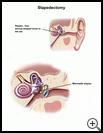
Ear Surgery for Hearing Loss: Stapedectomy
________________________________________________________________________
KEY POINTS
- A stapedectomy is surgery done to treat hearing loss.
- Ask your provider how long it will take to recover and how to take care of yourself at home.
- Make sure you know what symptoms or problems you should watch for and what to do if you have them.
________________________________________________________________________
What is a stapedectomy?
Sound waves go into the outer ear, down the ear canal, and to the eardrum in the middle ear. The sound waves make the eardrum and small bones behind the eardrum vibrate. One of the small bones is called the stapes. When the stapes vibrates, the fluid in the inner ear vibrates. This bends tiny hair cells in the inner ear. The hair cells turn the movement into electrical signals that get sent through nerves to your brain.
It is a normal process for bone to grow and for old bone to be replaced by new bone. If the stapes builds up too much old bone or is damaged by infection or injury, it cannot vibrate, leading to hearing loss. Stapedectomy is surgery to replace the bone with a manmade stapes.
This surgery can restore normal hearing in more than 90% of cases.
When is it used?
This surgery is done to treat hearing loss. In some cases the surgery may be done to allow better use of a hearing aid.
How do I prepare for this procedure?
- Make plans for your care and recovery after you have the procedure. Find someone to give you a ride home after the procedure. Allow for time to rest and try to find other people to help with your day-to-day tasks while you recover.
- Tell your healthcare provider if you have any food, medicine, or other allergies such as latex.
- Follow your provider's instructions about not smoking before and after the procedure. Smokers may have more breathing problems during the procedure and heal more slowly. It is best to quit 6 to 8 weeks before surgery.
- You may or may not need to take your regular medicines the day of the surgery. Tell your healthcare provider about all medicines and supplements that you take. Some products may increase your risk of side effects. Ask your healthcare provider if you need to avoid taking any medicine or supplements before the surgery.
- Tell your healthcare provider if you have an infection, such as a cold.
- Your healthcare provider will tell you when to stop eating and drinking before the surgery. This helps to keep you from vomiting during the surgery.
- Follow any instructions your healthcare provider may give you.
- Ask any questions you have before the surgery. You should understand what your healthcare provider is going to do. You have the right to make decisions about your healthcare and to give permission for tests or surgeries.
What happens during the procedure?
The surgery is usually done at a surgical center or the hospital.
You will be given medicine called anesthesia to keep you from feeling pain during the procedure. You may be given a local anesthetic to numb the area. You may also be given medicine to help you relax. The medicine can make you drowsy or you may fall asleep before the procedure. General anesthesia relaxes your muscles and puts you into a deep sleep.
Your healthcare provider will use a powerful microscope to look and work inside your ear. Your provider will make a cut in the ear canal near the eardrum. Your provider will remove part or all of the stapes and put a manmade stapes in place. Your provider will put a dressing in the ear canal and over the outer ear.
The surgery usually takes 1 to 1 and a half hours.
What happens after the procedure?
Often you can go home on the same day as the surgery.
Your hearing may not be much better right after the surgery because of the dressing in your ear, and because of swelling and bruising inside the ear. You may have dizziness, ringing or buzzing in your ear, or a change in your sense of taste for a while after the surgery.
Follow your healthcare provider's instructions. Ask your provider:
- How long it will take to recover
- If there are activities you should avoid and when you can return to your normal activities
- How to take care of yourself at home
- What symptoms or problems you should watch for and what to do if you have them
Make sure you know when you should come back for a checkup. Keep all appointments for provider visits or tests.
What are the risks of this procedure?
Every procedure or treatment has risks. Some possible risks of this procedure include:
- You may have problems with anesthesia.
- You may have infection or bleeding.
- If your eardrum is damaged, you may need more surgery to fix it.
Ask your healthcare provider how these risks apply to you. Be sure to discuss any other questions or concerns that you may have.

